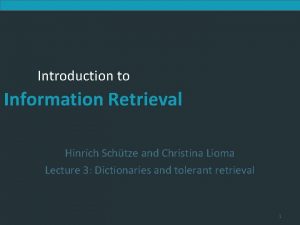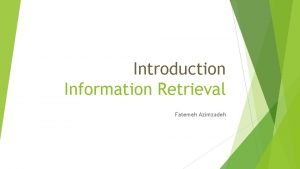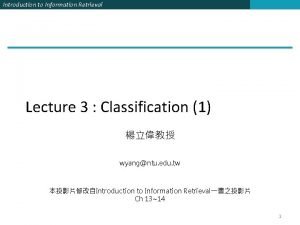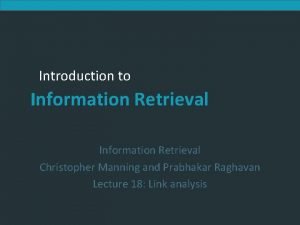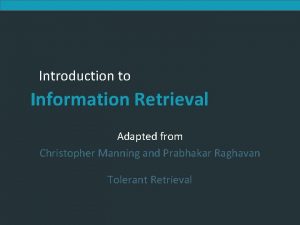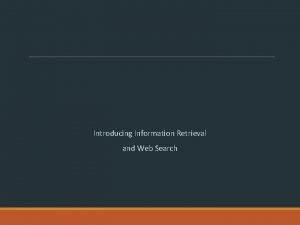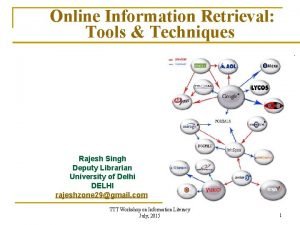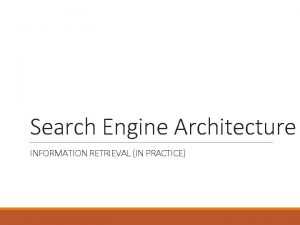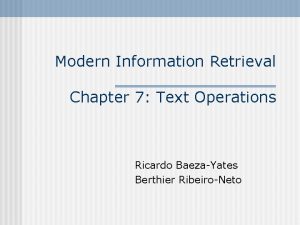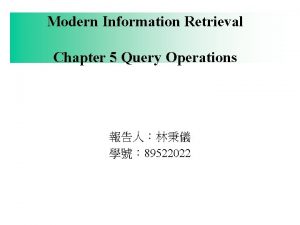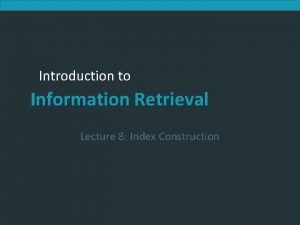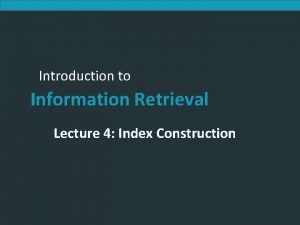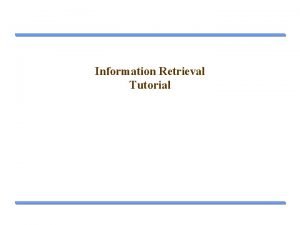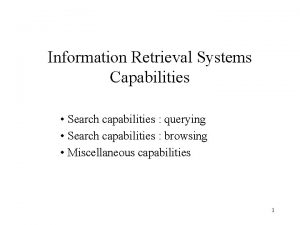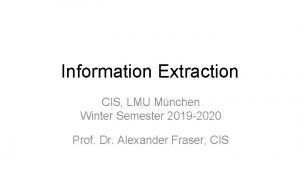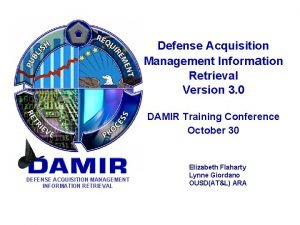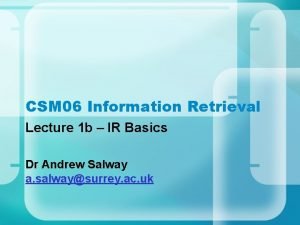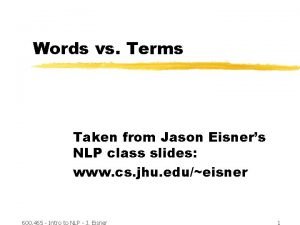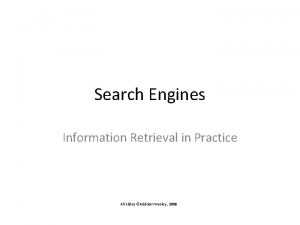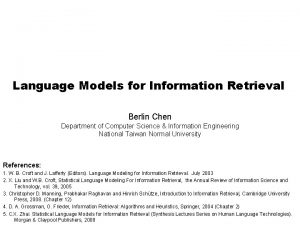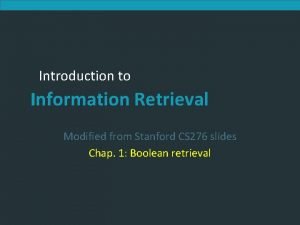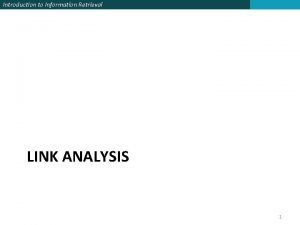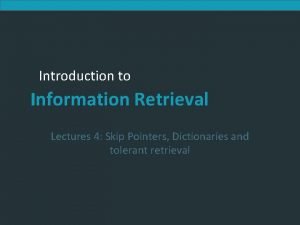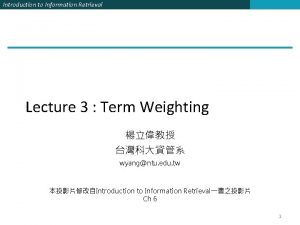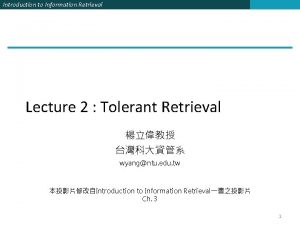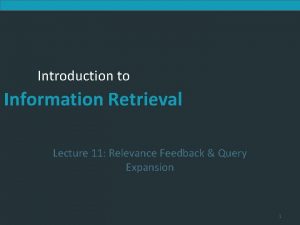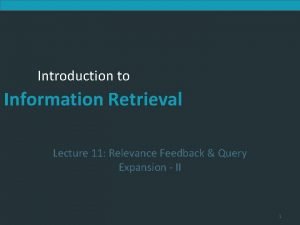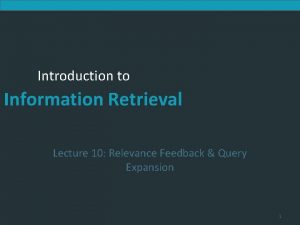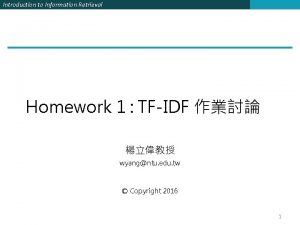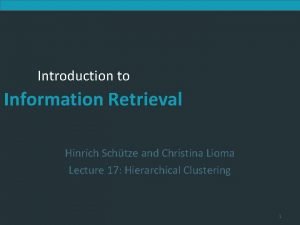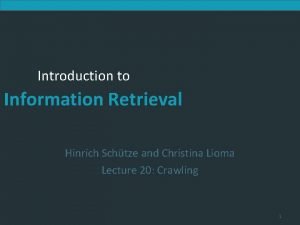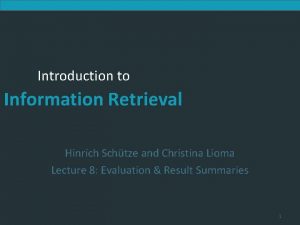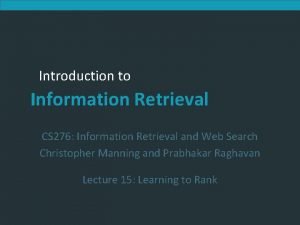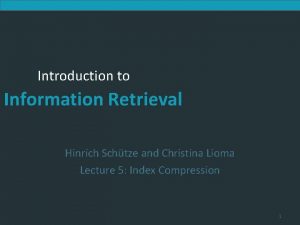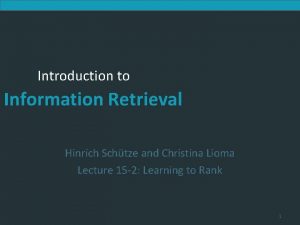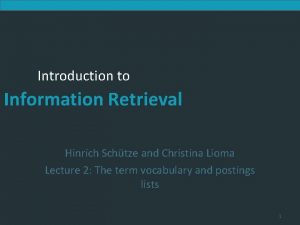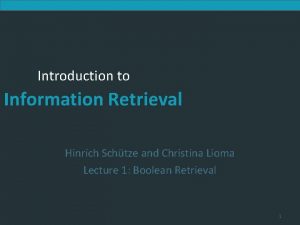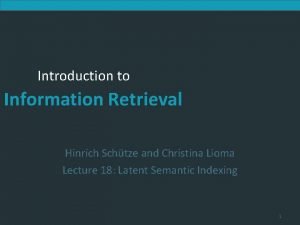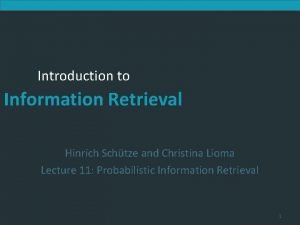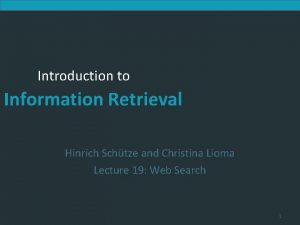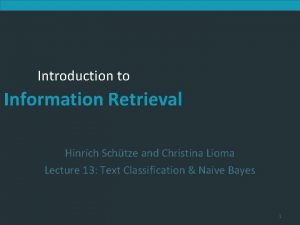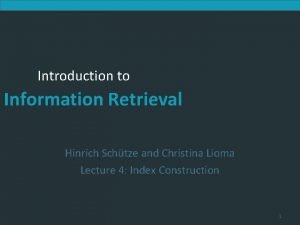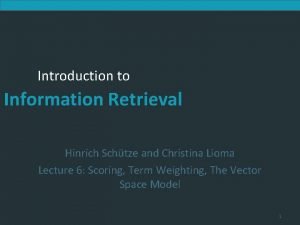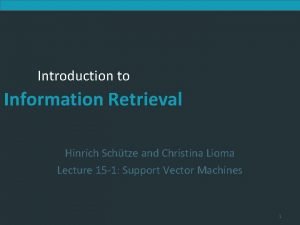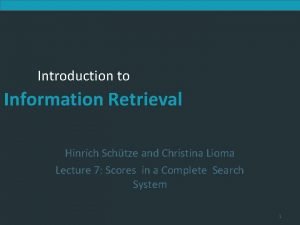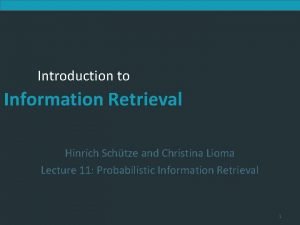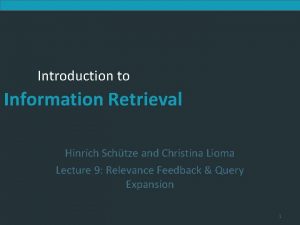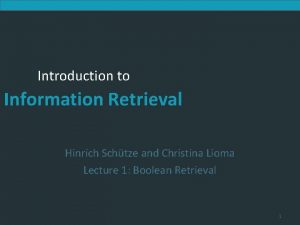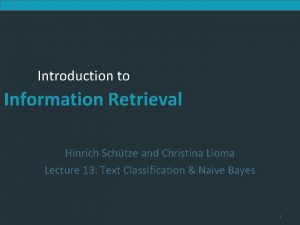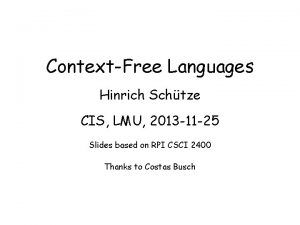Introduction to Information Retrieval Hinrich Schtze and Christina










































- Slides: 42

Introduction to Information Retrieval Hinrich Schütze and Christina Lioma Lecture 10: XML Retrieval 1

Introduction to Information Retrieval Overview ❶ Introduction ❷ Basic XML concepts ❸ Challenges in XML IR ❹ Vector space model for XML IR ❺ Evaluation of XML IR 2

Introduction to Information Retrieval Outline ❶ Introduction ❷ Basic XML concepts ❸ Challenges in XML IR ❹ Vector space model for XML IR ❺ Evaluation of XML IR 3

Introduction to Information Retrieval IR and relational databases IR systems are often contrasted with relational databases (RDB). Traditionally, IR systems retrieve information from unstructured text (“raw” text without markup). RDB systems are used for querying relational data: sets of records that have values for predefined attributes such as employee number, title and salary. Some structured data sources containing text are best modeled as structured documents rather than relational data (Structured retrieval). 4

Introduction to Information Retrieval Structured retrieval Basic setting: queries are structured or unstructured; documents are structured. Applications of structured retrieval Digital libraries, patent databases, blogs, tagged text with entities like persons and locations (named entity tagging) Example Digital libraries: give me a full-length article on fast fourier transforms Patents: give me patens whose claims mention RSA public key encryption and that cite US patent 4, 405, 829 Entity-tagged text: give me articles about sightseeing tours of the Vatican and the Coliseum 5

Introduction to Information Retrieval Why RDB is not suitable in this case Three main problems ❶ An unranked system (DB) would return a potentially large number of articles that mention the Vatican, the Coliseum and sightseeing tours without ranking them by relevance to query. ❷ Difficult for users to precisely state structural constraints – may not know which structured elements are supported by the system. tours AND (COUNTRY: Vatican OR LANDMARK: Coliseum)? tours AND (STATE: Vatican OR BUILDING: Coliseum)? ❸ Users may be completely unfamiliar with structured search and advanced search interfaces or unwilling to use them. Solution: adapt ranked retrieval to structured documents to address these problems. 6

Introduction to Information Retrieval Structured Retrieval Standard for encoding structured documents: Extensible Markup Language (XML) structured IR XML IR also applicable to other types of markup (HTML, SGML, …) 7

Introduction to Information Retrieval Outline ❶ Introduction ❷ Basic XML concepts ❸ Challenges in XML IR ❹ Vector space model for XML IR ❺ Evaluation of XML IR 8

Introduction to Information Retrieval XML document Ordered, labeled tree Each node of the tree is an XML element, written with an opening and closing XML tag (e. g. <title…>, </title…>) An element can have one or more XML attributes (e. g. number) Attributes can have values (e. g. vii) Attributes can have child elements (e. g. title, verse) <play> <author>Shakespeare</author> <title>Macbeth</title> <act number=“I”> <scene number=“”vii”> <title>Macbeth’s castle</title> <verse>Will I with wine …</verse> </scene> </act> </play> 9

Introduction to Information Retrieval XML document root element play element author element act text Shakespeare element title text Macbeth attribute number=“I” element scene attribute number=“vii” element verse element title text Shakespeare text Macbeth’s castle 10

Introduction to Information Retrieval XML document The leaf nodes root element play consist of text element author element act text Shakespeare element title text Macbeth attribute number=“I” element scene attribute number=“vii” element verse element title text Shakespeare text Macbeth’s castle 11

Introduction to Information Retrieval XML document The internal nodes encode document structure or metadata functions element author root element play element act text Shakespeare element title text Macbeth attribute number=“I” element scene attribute number=“vii” element verse element title text Shakespeare text Macbeth’s castle 12

Introduction to Information Retrieval XML basics XML Documents Object Model (XML DOM): standard for accessing and processing XML documents The DOM represents elements, attributes and text within elements as nodes in a tree. With a DOM API, we can process an XML documents by starting at the root element and then descending down the tree from parents to children. XPath: standard for enumerating path in an XML document collection. We will also refer to paths as XML contexts or simply contexts Schema: puts constraints on the structure of allowable XML documents. E. g. a schema for Shakespeare’s plays: scenes can occur as children of acts. Two standards for schemas for XML documents are: XML DTD 13 (document type definition) and XML Schema.

Introduction to Information Retrieval Outline ❶ Introduction ❷ Basic XML concepts ❸ Challenges in XML IR ❹ Vector space model for XML IR ❺ Evaluation of XML IR 14

Introduction to Information Retrieval First challenge: document parts to retrieve Structured or XML retrieval: users want us to return parts of documents (i. e. , XML elements), not entire documents as IR systems usually do in unstructured retrieval. Example If we query Shakespeare’s plays for Macbeth’s castle, should we return the scene, the act or the entire play? In this case, the user is probably looking for the scene. However, an otherwise unspecified search for Macbeth should return the play of this name, not a subunit. Solution: structured document retrieval principle 15

Introduction to Information Retrieval Structured document retrieval principle One criterion for selecting the most appropriate part of a document: A system should always retrieve the most specific part of a document answering the query. Motivates a retrieval strategy that returns the smallest unit that contains the information sought, but does not go below this level. Hard to implement this principle algorithmically. E. g. query: title: Macbeth can match both the title of the tragedy, Macbeth, and the title of Act I, Scene vii, Macbeth’s castle. But in this case, the title of the tragedy (higher node) is preferred. Difficult to decide which level of the tree satisfies the query. 16

Introduction to Information Retrieval Second challenge: document parts to index Central notion for indexing and ranking in IR: documents unit or indexing unit. In unstructured retrieval, usually straightforward: files on your desktop, email massages, web pages on the web etc. In structured retrieval, there are four main different approaches to defining the indexing unit ❶ non-overlapping pseudodocuments ❷ top down ❸ bottom up ❹ all 17

Introduction to Information Retrieval XML indexing unit: approach 1 Group nodes into non-overlapping pseudodocuments. Indexing units: books, chapters, section, but without overlap. Disadvantage: pseudodocuments may not make sense to the user because they are not coherent units. 18

Introduction to Information Retrieval XML indexing unit: approach 2 Top down (2 -stage process): ❶ Start with one of the latest elements as the indexing unit, e. g. the book element in a collection of books ❷ Then, postprocess search results to find for each book the subelement that is the best hit. This two-stage retrieval process often fails to return the best subelement because the relevance of a whole book is often not a good predictor of the relevance of small subelements within it. 19

Introduction to Information Retrieval XML indexing unit: approach 3 Bottom up: Instead of retrieving large units and identifying subelements (top down), we can search all leaves, select the most relevant ones and then extend them to larger units in postprocessing. Similar problem as top down: the relevance of a leaf element is often not a good predictor of the relevance of elements it is contained in. 20

Introduction to Information Retrieval XML indexing unit: approach 4 Index all elements: the least restrictive approach. Also problematic: Many XML elements are not meaningful search results, e. g. , an ISBN number. Indexing all elements means that search results will be highly redundant. Example For the query Macbeth’s castle we would return all of the play, act, scene and title elements on the path between the root node and Macbeth’s castle. The leaf node would then occur 4 times in the result set: 1 directly and 3 as part of other elements. We call elements that are contained within each other nested elements. Returning redundant nested elements in a list of returned hits is not very user-friendly. 21

Introduction to Information Retrieval Third challenge: nested elements Because of the redundancy caused by the nested elements it is common to restrict the set of elements eligible for retrieval. Restriction strategies include: discard all small elements discard all element types that users do not look at (working XML retrieval system logs) discard all element types that assessors generally do not judge to be relevant (if relevance assessments are available) only keep element types that a system designer or librarian has deemed to be useful search results In most of these approaches, result sets will still contain nested elements. 22

Introduction to Information Retrieval Third challenge: nested elements Further techniques: remove nested elements in a postprocessing step to reduce redundancy. collapse several nested elements in the results list and use highlighting of query terms to draw the user’s attention to the relevant passages. Highlighting Gain 1: enables users to scan medium-sized elements (e. g. , a section); thus, if the section and the paragraph both occur in the results list, it is sufficient to show the section. Gain 2: paragraphs are presented in-context (i. e. , their embedding section). This context may be helpful in interpreting the paragraph. 23

Introduction to Information Retrieval Nested elements and term statistics Further challenge related to nesting: we may need to distinguish different contexts of a term when we compute term statistics for ranking, in particular inverse document frequency (idf ). Example The term Gates under the node author is unrelated to an occurrence under a content node like section if used to refer to the plural of gate. It makes little sense to compute a single document frequency for Gates in this example. Solution: compute idf for XML-context term pairs. sparse data problems (many XML-context pairs occur too rarely to reliably estimate df) compromise: consider the parent node x of the term and not the 24 rest of the path from the root to x to distinguish contexts.

Introduction to Information Retrieval Outline ❶ Introduction ❷ Basic XML concepts ❸ Challenges in XML IR ❹ Vector space model for XML IR ❺ Evaluation of XML IR 25

Introduction to Information Retrieval Main idea: lexicalized subtrees Aim: to have each dimension of the vector space encode a word together with its position within the XML tree. How: Map XML documents to lexicalized subtrees. Microsoft Book Title Microsoft Bill Gates Title Author Microsoft Bill Gates Book Title Author Bill Gates Microsoft Bill . . . Gates 26

Introduction to Information Retrieval Main idea: lexicalized subtrees Take each text node (leaf) and break it into multiple nodes, one for each word. E. g. split Bill Gates into Bill and Gates ❷ Define the dimensions of the vector space to be lexicalized subtrees of documents – subtrees that contain at least one vocabulary term. ❶ Microsoft Book Title Microsoft Bill Gates Title Author Microsoft Bill Gates Book Title Author Bill Gates Microsoft Bill . . . Gates 27

Introduction to Information Retrieval Lexicalized subtrees We can now represent queries and documents as vectors in this space of lexicalized subtrees and compute matches between them, e. g. using the vector space formalism. Vector space formalism in unstructured VS. structured IR The main difference is that the dimensions of vector space in unstructured retrieval are vocabulary terms whereas they are lexicalized subtrees in XML retrieval. 28

Introduction to Information Retrieval Structural term There is a tradeoff between the dimensionality of the space and the accuracy of query results. If we restrict dimensions to vocabulary terms, then we have a standard vector space retrieval system that will retrieve many documents that do not match the structure of the query (e. g. , Gates in the title as opposed to the author element). If we create a separate dimension for each lexicalized subtree occurring in the collection, the dimensionality of the space becomes too large. Compromise: index all paths that end in a single vocabulary term, in other words all XML-context term pairs. We call such an XMLcontext term pair a structural term and denote it by <c, t>: a pair of XML-context c and vocabulary term t. 29

Introduction to Information Retrieval Context resemblance A simple measure of the similarity of a path cq in a query and a path cq in a document is the following context resemblance function CR: |cq| and |cd| are the number of nodes in the query path and document path, resp. cq matches cd iff we can transform cq into cd by inserting additional nodes. 30

Introduction to Information Retrieval Context resemblance example CR(cq, cd) = 3/4 = 0. 75. The value of CR(cq, cd) is 1. 0 if q and d are identical. 31

Introduction to Information Retrieval Context resemblance example CR(cq, cd) = ? CR(cq, cd) = 3/5 = 0. 6. 32

Introduction to Information Retrieval Document similarity measure The final score for a document is computed as a variant of the cosine measure, which we call SIMNOMERGE(q, d) = V is the vocabulary of non-structural terms B is the set of all XML contexts weight (q, t, c), weight(d, t, c) are the weights of term t in XML context c in query q and document d, resp. (standard weighting e. g. idft x wft, d, where idft depends on which elements we use to compute dft. ) SIMNOMERGE(q, d) is not a true cosine measure since its value can be larger than 1. 0. 33

Introduction to Information Retrieval SIMNOMERGE algorithm SCOREDOCUMENTSWITHSIMNOMERGE(q, B, V, N, normalizer) 34

Introduction to Information Retrieval Outline ❶ Introduction ❷ Basic XML concepts ❸ Challenges in XML IR ❹ Vector space model for XML IR ❺ Evaluation of XML IR 35

Introduction to Information Retrieval Initiative for the Evaluation of XML retrieval (INEX) INEX: standard benchmark evaluation (yearly) that has produced test collections (documents, sets of queries, and relevance judgments). Based on IEEE journal collection (since 2006 INEX uses the much larger English Wikipedia test collection). The relevance of documents is judged by human assessors. INEX 2002 collection statistics 12, 107 number of documents 494 MB size 1995— 2002 time of publication of articles 1, 532 average number of XML nodes per document 6. 9 average depth of a node 30 number of CAS topics 30 number of CO topics 36

Introduction to Information Retrieval INEX topics Two types: ❶ content-only or CO topics: regular keyword queries as in unstructured information retrieval ❷ content-and-structure or CAS topics: have structural constraints in addition to keywords Since CAS queries have both structural and content criteria, relevance assessments are more complicated than in unstructured retrieval 37

Introduction to Information Retrieval INEX relevance assessments INEX 2002 defined component coverage and topical relevance as orthogonal dimensions of relevance. Component coverage Evaluates whether the element retrieved is “structurally” correct, i. e. , neither too low nor too high in the tree. We distinguish four cases: ❶ Exact coverage (E): The information sought is the main topic of the component and the component is a meaningful unit of information. ❷ Too small (S): The information sought is the main topic of the component, but the component is not a meaningful (self-contained) unit of information. ❸ Too large (L): The information sought is present in the component, but is not the main topic. ❹ No coverage (N): The information sought is not a topic of the component. 38

Introduction to Information Retrieval INEX relevance assessments The topical relevance dimension also has four levels: highly relevant (3), fairly relevant (2), marginally relevant (1) and nonrelevant (0). Combining the relevance dimensions Components are judged on both dimensions and the judgments are then combined into a digit-letter code, e. g. 2 S is a fairly relevant component that is too small. In theory, there are 16 combinations of coverage and relevance, but many cannot occur. For example, a nonrelevant component cannot have exact coverage, so the combination 3 N is not possible. 39

Introduction to Information Retrieval INEX relevance assessments The relevance-coverage combinations are quantized as follows: This evaluation scheme takes account of the fact that binary relevance judgments, which are standard in unstructured IR, are not appropriate for XML retrieval. The quantization function Q does not impose a binary choice relevant/nonrelevant and instead allows us to grade the component as partially relevant. The number of relevant components in a retrieved set A of components can then be computed as: 40

Introduction to Information Retrieval INEX evaluation measures As an approximation, the standard definitions of precision and recall can be applied to this modified definition of relevant items retrieved, with some subtleties because we sum graded as opposed to binary relevance assessments. Drawback Overlap is not accounted for. Accentuated by the problem of multiple nested elements occurring in a search result. Recent INEX focus: develop algorithms and evaluation measures that return non-redundant results lists and evaluate them properly. 41

Introduction to Information Retrieval Recap Structured or XML IR: effort to port unstructured (standard) IR know-how onto a scenario that uses structured (DB-like) data Specialized applications (e. g. patents, digital libraries) A decade old, unsolved problem http: //inex. is. informatik. uni-duisburg. de/ 42
 Hinrich slobbe
Hinrich slobbe Document correction
Document correction Schtze
Schtze Introduction to information retrieval
Introduction to information retrieval Introduction to information retrieval
Introduction to information retrieval Introduction to information retrieval
Introduction to information retrieval Introduction to information retrieval manning
Introduction to information retrieval manning What is precision and recall in information retrieval
What is precision and recall in information retrieval Information retrieval and web search
Information retrieval and web search Information retrieval data structures and algorithms
Information retrieval data structures and algorithms Examples of information retrieval tools
Examples of information retrieval tools Signature file structure in information retrieval system
Signature file structure in information retrieval system What is sequential search
What is sequential search Search engine architecture
Search engine architecture Modern information retrieval
Modern information retrieval Query operations in information retrieval
Query operations in information retrieval Skip pointer information retrieval
Skip pointer information retrieval Index construction in information retrieval
Index construction in information retrieval Spimi
Spimi Which internet service is used for information retrieval
Which internet service is used for information retrieval Information retrieval tutorial
Information retrieval tutorial Wildcard query in information retrieval
Wildcard query in information retrieval Search capabilities in information retrieval system
Search capabilities in information retrieval system Link analysis in information retrieval
Link analysis in information retrieval Information retrieval lmu
Information retrieval lmu Defense acquisition management information retrieval
Defense acquisition management information retrieval Advantages of information retrieval system
Advantages of information retrieval system Information retrieval nlp
Information retrieval nlp Search engines information retrieval in practice
Search engines information retrieval in practice Relevance information retrieval
Relevance information retrieval Information retrieval stanford
Information retrieval stanford Link analysis in information retrieval
Link analysis in information retrieval Skip pointers
Skip pointers Information retrieval
Information retrieval Information retrieval
Information retrieval Information retrieval
Information retrieval Information retrieval
Information retrieval Relevance information retrieval
Relevance information retrieval Information retrieval
Information retrieval Information retrieval
Information retrieval Information retrieval
Information retrieval Information retrieval
Information retrieval Relevance information retrieval
Relevance information retrieval

